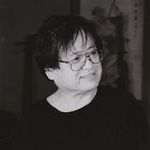Chimuo Nureki
Nureki (濡木) family name, Chimuo (痴夢男) first name, (1930- )
Contents
Activities
Kinbakushi, writer and editor.
Alternate Name(s)
濡木痴夢男(Japanese), IIda Toyokichi, Kanichiro Yutaka, Kanji Inada, etc..
Biography
Early Years
1930: Chimuo Nureki was born in Asakusa, Tokyo, and was the third generation of his family to be raised there.
c. 1938: Watching female sumo wrestling left an unforgettable impression on him[1].
1940: While a fifth grade elementary school student, Nureki saw a picture by Kashou Takabatake in which a boy was tied with his hands behind his back, and he became fascinated with pictures which appeared to show seppuku[1][note 1].
1940s: Nureki made a poster at the Health and Welfare public relations office of the Hitachi factory in Kameari where he was assigned during student mobilization[1][note 2].
1945: After the war, Nureki became an apprentice to Fukunosuke Ichikawa, a kabuki actor who played female roles in Shinsei Hanagata Kabuki[1][note 3].
1945: Met Seiu Ito in Asakusa[2].
1946: Another contact with Seiu Ito, this time at the Suzumoto Theater in Ichikawa City, Chiba Prefecture[2].
1946: Nureki spoke with a kabuki troupe and enrolled in a jidogeki theatrical company[1][note 4]. Nureki's first work was as an extra in a Toho movie co-starring Roppa Fukukawa and Ichirou Kagami[1][note 5].
Kitan Club Period
1953: Nureki became acquainted with Kitan Club around the time he was sent from a Tokyo design company to Nagoya, where he worked on a clothing-related advertising magazine[3][note 6].
1953: Pleasurable Punishment Performer was accepted for the November 1953 issue of Kitan Club[note 7]
c. 1953: Nureki saw Seiu Ito while at a performance of Burned Alive at the Suzumoto Theater.
1954: Publication of the March issue of Kitan Club is suspended. Nureki published the content of "Demon Sisters" (illustrated by by Yagi Shizuo) with Fujio Maki, but there was a problem with release, and sale was prohibited four days later[3].
1955: Kitan Club resumed sales with the October issue under a new publisher, Tenseisya, which oversaw the magazine's cover design (the white cover period). Nureki wrote many of the stories in this issue.
Uramado Period
1957: Nureki returned to Tokyo. Shortly before leaving Nagoya, he discovered Uramado magazine in a Matsuzaka book store and came across Reiko Kita's name[3].
1957 (December): "The Pale Man" was published in Uramado under the pen name Toyokichi IIda[note 8]. After that, Nureki contributed to both Kitan Club and Uramado magazines. Later, he paid a visit to Toshiyuki Suma at Uramado's editorial office in Ekota[2].
Selected Works
How-to-Kinbaku
- 濡木痴夢男の縛り方入門1 (Nureki Chimuo's Introductory Guide to Shibari No.1) (Art Video, 1983)
- 濡木痴夢男の縛り方入門2 (Nureki Chimuo's Introductory Guide to Shibari No.2) (Art Video, 1983)
- 濡木痴夢男の縛り方入門3 (Nureki Chimuo's Introductory Guide to Shibari No.3) (Art Video, 1983)
- 濡木痴夢男の縛り方入門4 (Nureki Chimuo's Introductory Guide to Shibari No.4) (Art Video, 1983)
- 濡木痴夢男の縛り方入門5 (Nureki Chimuo's Introductory Guide to Shibari No.5) (Art Video, 1983)
- 濡木塾 I :濡木痴夢男新縛り方教室(Nureki School: Nureki Chimuo's New Introductory Guide to Shibari)(Art Video, 1988)
- 秘技伝授 緊縛入門 (Initiation of Secret Technique: Introductory Class of Shibari) (SOD Create, 2001)
References
- ↑ 1.0 1.1 1.2 1.3 1.4 1.5 Nureki, Chimuo. Nureki Chimuo's Chat Theater. Web.
- ↑ 2.0 2.1 2.2 Nureki, Chimuo. The Artists of Kitan Club. Tokyo: Kawade Shobo, 2004. Print.
- ↑ 3.0 3.1 3.2 Nakahara, Rutsu. "Another Face of Chimuo Nureki". Bondage - For As Long As I Live (Afterward). Tokyo: Kawade Shobo, 2008. Print.
Notes
- ↑ Nureki lived with his parents and a younger brother and sister in a two-story wooden house in Ryuusenjichou in Asakusa. He read the authors Edogawa Ranpo, Kyuusaku Yumeno, Udaru Oshita, Saburou Kouga, Juuza Unno and Junichirou Tanizaki repeatedly.
- ↑ Nureki received guidance from Ichirou Madokoro, a member of Taiheiyogakai.
- ↑ Based at a remodeled playhouse near Kameari Station. The 'Hanagata Kabuki Troupe had once been located at a theater in Honjo Midoricho, but was re-established in Kameari as Shinsei Hanagata Kabuki (Leaders: Tsuruzou Kantou and Takewaka Kantou) after evacuating Honjo Midoricho due to the destruction caused by aerial bombing.
- ↑ The troupe isn't specified, but it is thought to be Gekidan Toudou, which was active between 1928 and 1980.
- ↑ "I remember it seemed to have a title like If My Song Had Wings." The actual work is unconfirmed. One possibility is My Father (Toyotarou, 1946).
- ↑ Rutsu Nakahara places it with a Japanese PR magazine in the afterward to Nureki's "Bondage - For As Long As I Live."
- ↑ He had really wanted it to be illustrated by Reiko Kita, but Toshiyuki Suma had already left the magazine by that time. Mineko Tsuzuki Illustrated it instead.
- ↑ "Written on a train returning to Tokyo" (Bondage - For As Long As I Live (Afterward) by Rutsu Nakahara)
